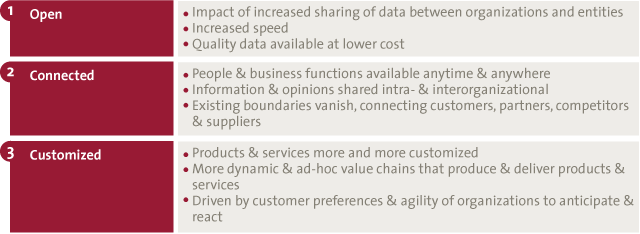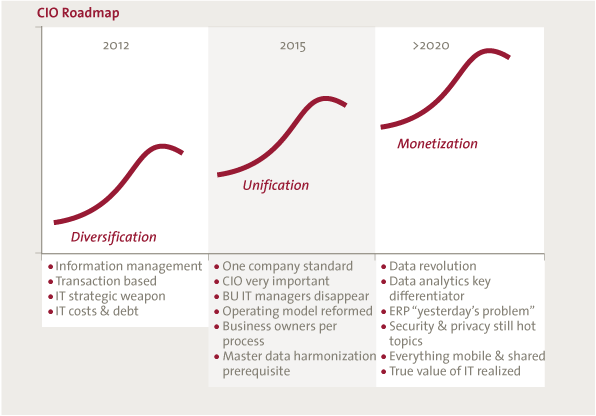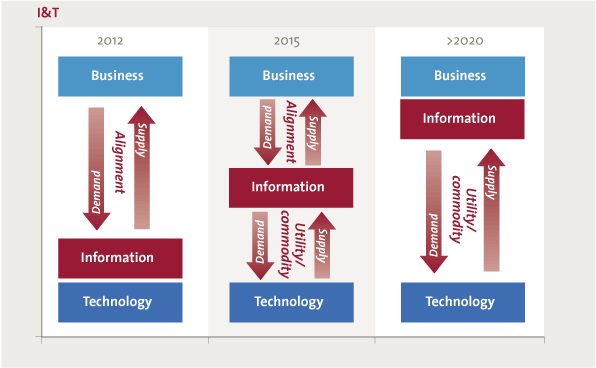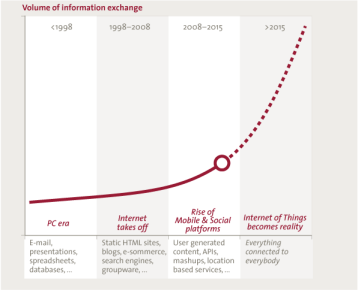The role and position of the CIO have been under debate ever since IT arose. The importance of IT, (big) data/information has increased dramatically and is, or should be, making it a board level topic. The role of the CIO cannot remain the same in this fast changing arena. We will share our vision on the future role of the CIO and other classic intermediary functions and aim to further feed the discussion in this area.
We are all confronted with an increasingly digitized world, whether we like it or not. Travel arrangements, shopping, banking and communicating are all common activities that are affected by this rapid transformation. Consumers have the world at their fingertips, where (organizational and corporate) boundaries are becoming irrelevant.
But how does this affect the IT organization, and more specifically, the role of the CIO and related functions? We believe a paradigm shift is at hand that will eventually make the CIO redundant, along with information management and other classic intermediary functions.
Today’s world
In today’s world, IT is rapidly becoming a basic infrastructural necessity, comparable with utilities like electricity, water and so on. It has to be available any time, any place; and it must be included in more and more different devices, such as lighting appliances, switches, thermostats, watches, etc. In addition, all those applications of IT are being connected to support the exchange of information, location-based services and so on.
As a consequence, the amount of data that is becoming available is exploding, and the volume will continue to grow at a mindboggling pace (see Figure 1), which is also supported by initiatives like “open data.”
Figure 1. Exploding volumes of information (source: www.competingoninformation.com). [Click on the image for a larger image]
Furthermore, data is becoming more liquid in the sense that organizational or corporate boundaries are less relevant. The information “arena” for CxO’s is expanding dramatically as a result of the blurred lines between internal and external data. At the same time, power is rapidly shifting from producers to consumers as a result of increased transparency and globalization. Producers are consequently forced to develop capabilities for mass-customization in flexible, virtual value chains.
In short, the typical characteristics of this new era, also called “the information age,” are that it is “connected,” “open” and “customized,”[Ref. CIO Magazine, No. 5, 2013; “IT, of Informatie & Technologie,” by G.A. Damen, B. te Wierik and E.J. Mutsaers] introducing new opportunities and challenges for the CIO and related key functions (see Figure 2).

Figure 2. Characteristics of the “information age”.
The dilemma
Traditionally IT has been the domain of “wizards,” impossible or at least very difficult for business managers to comprehend and manage. To a certain extent, this is still the case. Truly understanding the IT domain and the relevant (cost) drivers has been, and partly still is, one of the major challenges for business management, including the CEO, CFO and COO. In many cases annual IT expenditure has increased year after year, while business management keeps complaining about the poor quality of the services being provided. As a result, IT-related decision making and priority-setting is potentially done based upon intuition or “opinions” and without really understanding the possible alternatives or the full implications of those choices (e.g., the impact upon annual costs of maintenance and operations, risk-profile, etc).
Typically, a “CIO” (or comparable role) has been introduced to address these challenges and to support business management in the IT arena. Not all CIO’s introduced are positioned or truly acting on CxO level.
Some are (initially) primarily occupied with running the IT infrastructure and applications, thereby ensuring business (as usual) continuity. Others have delegated that responsibility to an IT manager or CTO and are themselves focused on the potential added value of information and technology for the business. In most cases the level of maturity of the IT (organization) determines which type of CIO is most appropriate at a certain point in time.
In many cases, the CIO is initially reporting to the CFO, who serves as “the last line of defence” in the battle against growing IT expenditure and dissatisfied business management. The first task is likely to be maintaining day-to-day operations within tight budgetary constraints, which in a legacy environment is a challenge on its own.
Once this first hurdle has been passed, the long-term IT strategy to support the business goals with appropriate information and technology becomes the next challenge. The question is whether or not this second challenge can be addressed with the same skill set as the first, and whether or not the required competencies for both challenges can be found in one and the same person.
Many CIO’s today are mainly occupied with the issues of today and tomorrow, and are still operating in a phase of “diversification” (see Figure 3). They spend most of their time and resources in their legacy environment and do not have sufficient time and resources available to execute a long-term IT strategy. They are unable to attend to unification of business processes, data and IT solutions, which is a pre-requisite for “monetization” in the information age.
This deadlock poses the biggest hurdle to realizing the full potential of the CIO; a breakthrough approach is required. Sometimes the breakthrough approach is to fire the current CIO.

Figure 3. KPMG Vision on the CIO roadmap 2020.
In a phase of diversification with focus on the legacy environment, typical control mechanisms are:
- generic budget constraints and cut-backs
- (financial) portfolio management on a basic maturity level (providing overview without enabling guidance towards strategic objectives)
- financial management and charge-back without enabling business management to anticipate and manage IT spending
These kinds of mechanisms emphasize the existing gap between business (management) and IT (management) and so they will not facilitate a transition to the information age. If not managed properly, they may well prevent advancing into a digitized world.
In this new, digitized information age, value chains are more and more interlinked. They are becoming virtual by enriching physical products with information (services). Consumers are defining new virtual value chains on a day-to-day basis, requiring a very responsive and flexible organization (contributor in a virtual value chain) to deal with this turbulent, continuous changing environment. Time-to-market has to be reduced dramatically to be able to respond to actual and unpredictable consumer-demands. The traditional business (demand) and IT (supply) alignment mechanisms are not suitable for this transition.
In short, a breakthrough will not likely be achieved by just optimizing today’s IT environment with today’s IT control mechanisms. This dilemma is also being referred to as the “alignment-trap.” The CIO needs to strengthen his or her role on the CxO level to guide business and IT management into this new phase. The first step will be “unification” as a stepping-stone towards monetization.
How to move forward
How will (or should) this affect the role of the CIO and related functions? In our opinion, business management will eventually become responsible for data and information, and the traditional “marriage” between information and technology will cease to exist in its current form. Technology will be handled and sourced by the IT manager or CTO, and will be treated like a commodity or infrastructural utility (see Figure 4).

Figure 4. The separation of I&T; a paradigm shift.
Common reactions against this phenomenon from the IT community are that business management isn’t capable of taking on this responsibility and needs the IT organization to act on its behalf. Business management, from their point of view, traditionally prefers not to be associated with the technical side of “IT,” which is considered to be a low strategic added value, and prefers to delegate this responsibility to intermediary functions, like information management. More modern business managers may tend to ignore the “old-school” IT department and start arranging their own information and technology infrastructure.
The key objective for the CIO should therefore become how to make the CIO role and other classic intermediary functions obsolete, at least as they currently exist. In order to achieve this goal, a paradigm-shift is required in thinking about business and IT alignment.
To facilitate this paradigm shift and close the alignment-gap poses quite a challenge, but is likely to consist of a number of changes:
- break down the alignment mechanisms and start working on a symbiotic relationship with business and IT by:
- decentralization of business-related IT functions (e.g., information management), positioned as close to the business as possible
- educating IT professionals to really understand the business (processes) and enabling them to add value on a day-to-day basis
- educating business management in IT-related topics and issues for improved decision making and focus on realizing the strategic goals
- enable the CIO to focus on the transition (unification and monetization) and the “CTO” on ensuring infrastructural utilities (inhouse or outsourced) and arrangements for commoditized IT services
- manage the strategic portfolio of (IT) programs and projects at the board-level, to ensure focus and commitment for renewal
In this scenario, the typical CIO role will eventually cease to exist as a separate function, along with information management and other intermediary functions. Will this be the end of the current CIO in general, or will a new, changed CIO role emerge? Will the CIO’s current role become an integral part of the role of the CEO, COO, CFO and business management, or will the role change to a staff function, acting as policy maker and guardian of the corporate IT infrastructure? It is still difficult to predict, but one thing we know for sure, the CIO and other classic intermediary functions will not remain the same! Adapt or become obsolete seems to be the new credo.






